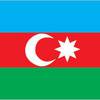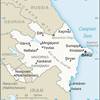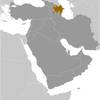Azerbaijan [+]Compare [E]dit [H]istory
Aliases: Azarbaycan, Azarbaycan Respublikasi, Azerbaijan Soviet Socialist Republic, Republic of AzerbaijanObject «Azerbaijan» was created due to
Add new object to «Azerbaijan» or move existing objects here.
Object «Azerbaijan» has attributes [Show empty attributes][Hide empty attributes]
| Attribute | Value |
|---|---|
| Geography | |
| Area | 86,600 km² |
| Continent | Asia |
| Land area | 82,629 km² |
| Water area | 3,971 km² |
| Land boundaries | 2,468 km |
| Border countries |
|
| Coastline | 0 km |
| Mean elevation | 384 m |
| Lowest point | -28 m |
| Highest point | 4,466 m |
| People | |
| Population | 10,205,810 |
| Official languages |
|
| Religion | Muslim |
| Government | |
| Long country name | Republic of Azerbaijan |
| Short country name | Azerbaijan |
| Long local name | Azarbaycan Respublikasi |
| Short local name | Azarbaycan |
| Former name |
|
| Government type | Presidential republic |
| Capital | Baku |
| Economy | |
| GDP (PPP) | 172,200,000,000 USD |
| GDP (OER) | 40,670,000,000 USD |
| GDP (real growth rate) | 0.1 % |
| GDP - per capita (PPP) | 17,500 USD |
| Gross national saving | 24.6 % of GDP |
| Labor force | 5,118,000 |
| Unemployment rate | 5 % |
| Population below poverty line | 4.9 % |
| Budget revenues | 9,556,000,000 USD |
| Budget expenditures | 10,220,000,000 USD |
| Military expenditures | 3.77 % of GDP |
| Taxes and other revenues | 23.5 % of GDP |
| Budget surplus or deficit | -1.6 % of GDP |
| Public debt | 54.1 % of GDP |
| Inflation rate | 13 % |
| Central bank discount rate | 15 % |
| Commercial bank prime lending rate | 12.7 % |
| Stock of narrow money | 6,202,000,000 USD |
| Stock of broad money | 6,202,000,000 USD |
| Stock of domestic credit | 13,310,000,000 USD |
| Market value of publicly traded shares | Add |
| Current account balance | 1,685,000,000 USD |
| Exports | 15,150,000,000 USD |
| Imports | 9,037,000,000 USD |
| Reserves of foreign exchange and gold | 6,681,000,000 USD |
| External debt | 17,410,000,000 USD |
| National currency | Azerbaijani manats |
| National currency (code) | AZN |
| National currency (symbol) | ман |
| National currency rate to USD | 1.723 |
Azerbaijan - a secular nation with a majority-Turkic and majority-Shia Muslim population - was briefly independent (from 1918 to 1920) following the collapse of the Russian Empire; it was subsequently incorporated into the Soviet Union for seven decades. Azerbaijan remains involved in the protracted Nagorno-Karabakh conflict with Armenia. Nagorno-Karabakh was a primarily ethnic Armenian region that Moscow recognized in 1923 as an autonomous oblast within Soviet Azerbaijan. In the late Soviet period, a separatist movement developed which sought to end Azerbaijani control over the region. Fighting over Nagorno-Karabakh began in 1988 and escalated after Armenia and Azerbaijan attained independence from the Soviet Union in 1991. By the time a ceasefire took effect in May 1994, separatists, with Armenian support, controlled Nagorno‑Karabakh and seven surrounding Azerbaijani territories. The 1994 ceasefire continues to hold, although violence continues along the line of contact separating the opposing forces, as well as the Azerbaijan-Armenia international border. The final status of Nagorno-Karabakh remains the subject of international mediation by the Organization for Security and Cooperation in Europe (OSCE) Minsk Group, which works to help the sides settle the conflict peacefully. The OSCE Minsk Group is co‑chaired by the United States, France, and Russia.
In the 25 years following its independence, Azerbaijan succeeded in significantly reducing the poverty rate and has directed revenues from its oil and gas production to develop the country’s infrastructure. However, corruption remains a problem, and the government has been accused of authoritarianism. The country’s leadership has remained in the Aliyev family since Heydar ALIYEV became president in 1993 and was succeeded by his son, President Ilham ALIYEV in 2003. Following two national referendums in the past several years that eliminated presidential term limits and extended presidential terms from 5 to 7 years, President ALIYEV secured a fourth term as president in April 2018 in an election that international observers noted had serious shortcomings. Reforms are underway to diversify the country’s non-oil economy and additional reforms are needed to address weaknesses in government institutions, particularly in the education and health sectors, and the court system.
Similar objects
- [⇄] [+] Gambia, The
- [⇄] [+] Madagascar
- [⇄] [+] Malawi
- [⇄] [+] Tanzania
- [⇄] [+] Uzbekistan
Most often compared with
Everyone can something to edit or add.
There was one edit, no edits waiting approval. Last edited by jmcdermott(9391), Sep 15, 2019 (64 fields were changed)
Help · Contact us · Disclaimer · Contributors · Developers · Donate


